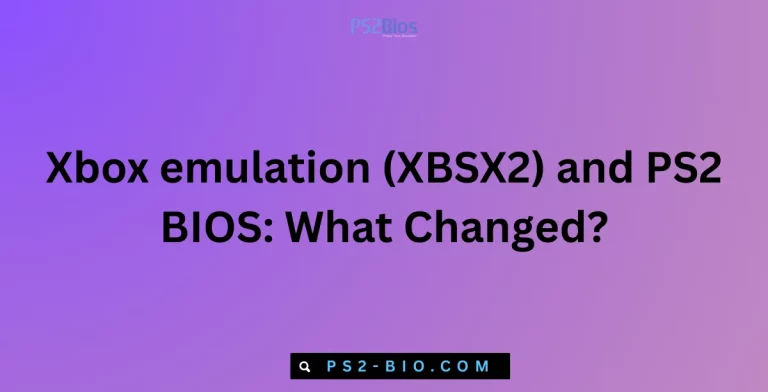BIOS in Emulator Development: Clean-Room Approaches & Avoiding IP Issues
How can emulators run console games without infringing copyrights? Understanding BIOS in emulator development and applying clean-room methods helps developers legally recreate essential system firmware while avoiding intellectual property risks and ensuring accurate hardware emulation.

What Is BIOS in Emulator Development?
BIOS (Basic Input/Output System) is a low-level software that initializes hardware and provides essential runtime services for operating systems and applications. In emulators, the BIOS is critical because it replicates the behavior of the original console or computer hardware.
Without BIOS, emulators may struggle to boot games, manage memory, or process input correctly. Using an original BIOS file from a console can create legal issues, as it remains the property of the console manufacturer. Therefore, understanding legal alternatives is essential for safe emulator development.
The Role of BIOS in Accurate Emulation
A console’s BIOS handles multiple functions:
- System Initialization: Starts hardware components in the correct sequence.
- Peripheral Management: Controls inputs from controllers, memory cards, and other devices.
- Game Loading & Security: Verifies game integrity and prevents unauthorized software.
For emulators, replicating these functions ensures games run reliably and mimic the original console experience. Errors in BIOS emulation can lead to crashes, slow performance, or inaccurate graphics and audio.
Legal Challenges of Using Original BIOS
Using original BIOS files without permission violates intellectual property (IP) laws, including copyright protections. Companies like Sony, Nintendo, and Microsoft hold exclusive rights over console BIOS software.
Key legal points include:
- Copyright Violation: Copying or distributing BIOS files is illegal.
- Licensing Restrictions: Even owning a console does not grant the right to distribute BIOS.
- Liability Risks: Publicly releasing BIOS-dependent emulators can trigger legal action.
Developers must adopt clean-room approaches to avoid these risks while still delivering accurate emulation.
Understanding Clean-Room BIOS Development
Clean-room development is a method where software is recreated without directly copying the original BIOS code. It involves two independent teams:
- Specification Team: Analyzes the BIOS’s behavior through testing and documentation without accessing the original source code.
- Implementation Team: Uses only the specifications to write a new BIOS from scratch.
This process ensures the new BIOS replicates functionality without infringing copyright. By isolating the development teams, emulators can legally include BIOS functionality.
Steps to Implement Clean-Room BIOS
- Document Original BIOS Behavior:
- Record system responses to various commands.
- Analyze how memory, input devices, and graphics are handled.
- Create a Functional Specification:
- Write detailed descriptions of BIOS behavior.
- Include initialization sequences, error handling, and peripheral protocols.
- Independent Implementation:
- Developers recreate BIOS solely from the specification.
- Avoid any direct copying or reverse engineering of the original code.
- Testing and Validation:
- Compare outputs with original hardware results.
- Ensure compatibility with multiple games and system functions.
This method allows emulators to provide accurate and stable performance without infringing IP.
Benefits of Clean-Room BIOS Approaches
- Legal Safety: Reduces risk of copyright infringement claims.
- Cross-Platform Compatibility: Enables BIOS to run on various operating systems.
- Community Trust: Users can safely download and use the emulator.
- Maintainability: Developers can update and optimize BIOS code freely.
Clean-room BIOS development has been successfully applied in emulators like PCSX2 (PlayStation 2) and Dolphin (GameCube/Wii), ensuring long-term project sustainability.
Common Misconceptions About BIOS in Emulation
- “All BIOS must be copied from the original console.”
- False. Clean-room BIOS allows emulation without copying.
- “Clean-room development is too slow.”
- While it takes effort, proper specifications accelerate testing and reduce future legal complications.
- “Emulation is illegal if it includes BIOS.”
- Only unauthorized use of original BIOS is illegal. Independent, clean-room implementations are legal.
Understanding these points helps developers balance functionality with compliance.
Alternatives to Clean-Room BIOS
- High-Level Emulation (HLE):
- Replaces BIOS calls with software approximations.
- Often faster but may reduce accuracy.
- Open-Source BIOS Projects:
- Some communities create legally distributable BIOS alternatives.
- Example: U-Boot or OpenBIOS, primarily for older systems.
- User-Provided Original BIOS:
- Some emulators require users to supply their own legally obtained BIOS.
- This approach avoids distribution liability while retaining full accuracy.
Each method has trade-offs between accuracy, speed, and legal safety.
Technical Challenges in Clean-Room BIOS
- Hardware Complexity: Modern consoles have intricate security and initialization routines.
- Peripheral Support: Accurate controller, memory card, and GPU behavior must be replicated.
- Firmware Updates: Some BIOS features depend on console firmware updates, which must be carefully mimicked without copying.
Overcoming these challenges requires detailed testing, extensive documentation, and iterative development.
Case Study: PCSX2 BIOS Implementation
PCSX2, a popular PlayStation 2 emulator, uses a combination of:
- User-supplied original BIOS (to comply with legal restrictions).
- Partial high-level emulation for system functions.
The developers provide clear guidance on legal BIOS usage, ensuring users are not exposed to copyright infringement. This approach balances accuracy and compliance, serving as a model for emulator projects.
Best Practices for Emulator Developers
- Document Behavior Thoroughly: Avoid assumptions; test every system response.
- Use Independent Teams: Isolate specification and implementation to maintain clean-room integrity.
- Keep Code Modular: Easier maintenance, testing, and updates.
- Educate Users: Provide clear instructions on BIOS legality and acquisition.
- Stay Updated: Monitor console firmware changes to maintain accurate emulation.
Following these practices reduces risk and enhances software reliability.
Summary: Balancing Accuracy and Legal Compliance
BIOS is crucial for accurate emulation, but direct copying risks legal action. Clean-room approaches allow developers to:
- Replicate console functionality safely.
- Avoid copyright infringement.
- Maintain long-term emulator sustainability.
By combining documentation, specification, independent implementation, and rigorous testing, emulators can deliver high-quality performance while protecting both developers and users.
Clean-room BIOS development represents a strategic approach for emulators targeting consoles from Sony, Nintendo, and other major brands, ensuring legality and authenticity simultaneously.






